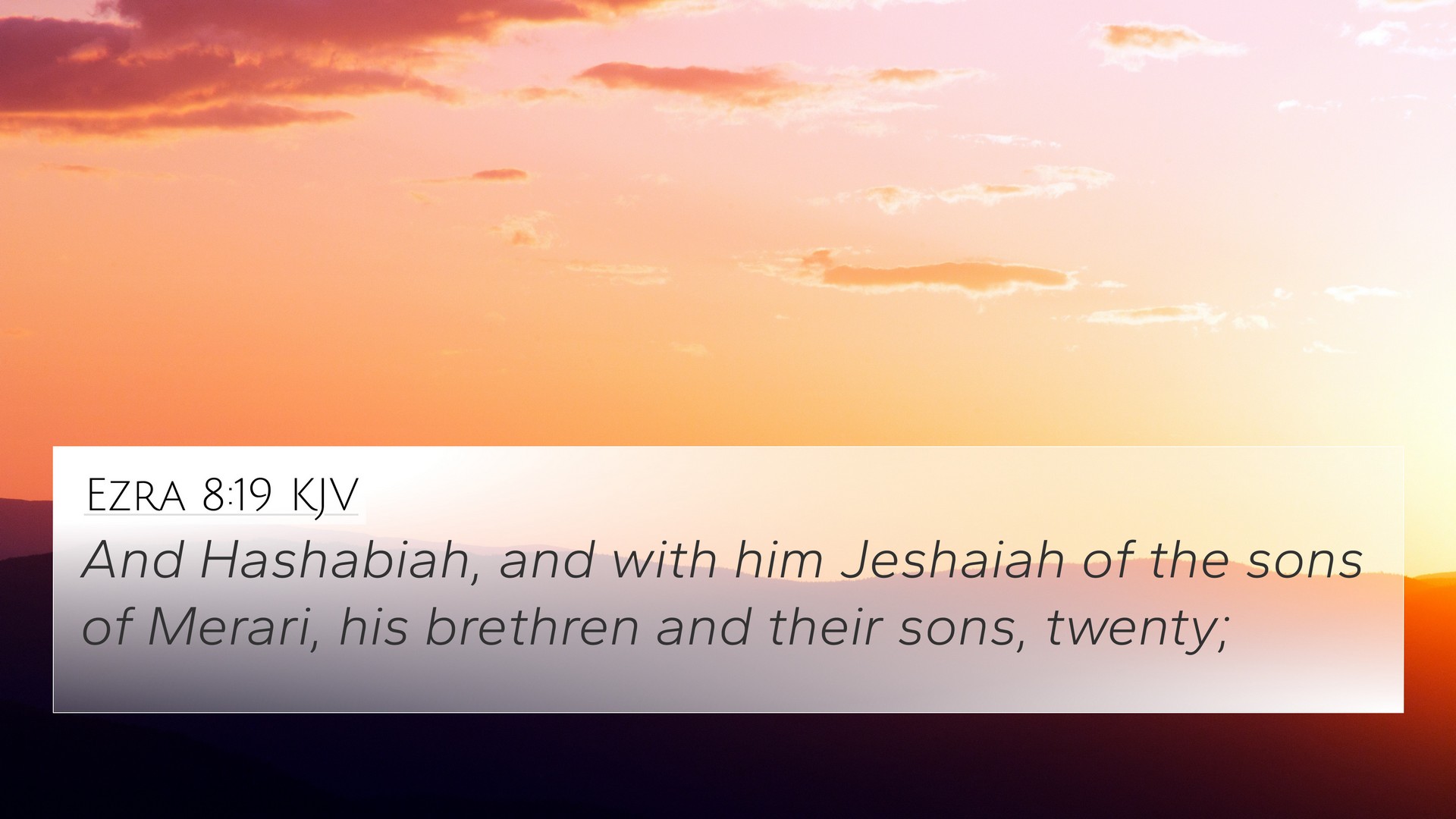Understanding Ezra 8:19
Ezra 8:19 states: "And Hashabiah, and with him Jeshaiah of the sons of Merari, his brethren and their sons, twenty." This verse provides a brief insight into the Levite leaders entrusted with the sacred responsibilities during the return from Babylonian captivity.
Context of Ezra 8:19
To fully grasp Ezra 8:19, one must consider its surrounding verses. Ezra is leading a group of exiles back to Jerusalem, and he emphasizes the importance of spiritual authority and the roles of the Levites. This reflects the restoration of Jewish worship and community following a long period of exile.
Commentary Insights
- Matthew Henry's Commentary: Henry highlights the significance of the families of the Levites and their roles in ministering before God. He notes that their inclusion points to the importance of proper worship and adherence to the law.
- Albert Barnes' Notes: Barnes emphasizes the structured organization of the Levite families and their responsibilities, which were critical for maintaining worship practices in Jerusalem.
- Adam Clarke's Commentary: Clarke notes that the precise names and numbers reflect the serious nature of the covenant community and their role in restoring worship post-exile.
Meaning and Application
This verse serves as a reminder of the importance of community leadership and the vital role of those appointed to spiritual responsibilities. The mention of family connections emphasizes how vital it was for the community to redefine its identity after returning from exile.
Bible Verse Cross-References
Ezra 8:19 connects richly with various other scriptures, illustrating foundational themes of leadership, community, and worship in the Old Testament.
- Exodus 28:1: God appoints Aaron and sons to serve as priests, establishing the Levitical line.
- Numbers 3:6-10: The duties of the Levites are outlined, emphasizing their responsibilities among the Israelites.
- 1 Chronicles 23:3-5: A listing of Levitical families and their specific tasks in the temple.
- Nehemiah 10:39: This verse highlights the importance of bringing the offerings to the priests and Levites, underscoring their vital role in worship.
- Hebrews 7:14: This New Testament text references the Levitical priesthood, connecting the responsibilities of Levites to the priesthood of Christ.
- Deuteronomy 12:12: Encourages rejoicing along with the Levitical priests, highlighting their importance in the worship community.
- Malachi 2:4-7: Discusses the covenant with Levi and their role in teaching the Law.
Connections Between Bible Verses
The narrative of Ezra 8:19 is part of a broader thematic conversation about restoration and community leadership in Scripture. By analyzing cross-references, we see a composite picture of how the Levites function within God’s larger plan.
Scriptural Cross-Referencing Tools
For those interested in deeper study, utilizing Bible concordance tools can aid in identifying connections between Bible verses. A comprehensive Bible cross-reference guide will also assist in developing a broader understanding of themes like leadership and worship found throughout Scripture.
Cross-Reference Bible Study Methods
To effectively engage in cross-referencing Bible study, consider the following approaches:
- Utilize a Bible reference resource to trace themes or words through Scripture.
- Practice cross-reference Bible study by comparing parallel verses to derive richer meanings.
- Conduct a comparative study of Pauline epistles which can offer insights on leadership and community similar to Ezra’s context.
Interpreting Biblical Themes
Interpreting Biblical themes through cross-references can illuminate the continuity and dialogue between the Old and New Testaments. For example, examining themes of worship can draw significant parallels between the levitical practices in Ezra and Jesus’ teachings in the Gospels.
Conclusion
Ezra 8:19 is not just a historical account; it is an invitation for today’s believers to appreciate the importance of leadership, community, and worship instruction within the church. Through careful cross-referencing Biblical texts, we uncover a tapestry of divine purpose and community structure that continues to resonate in the lives of believers.







